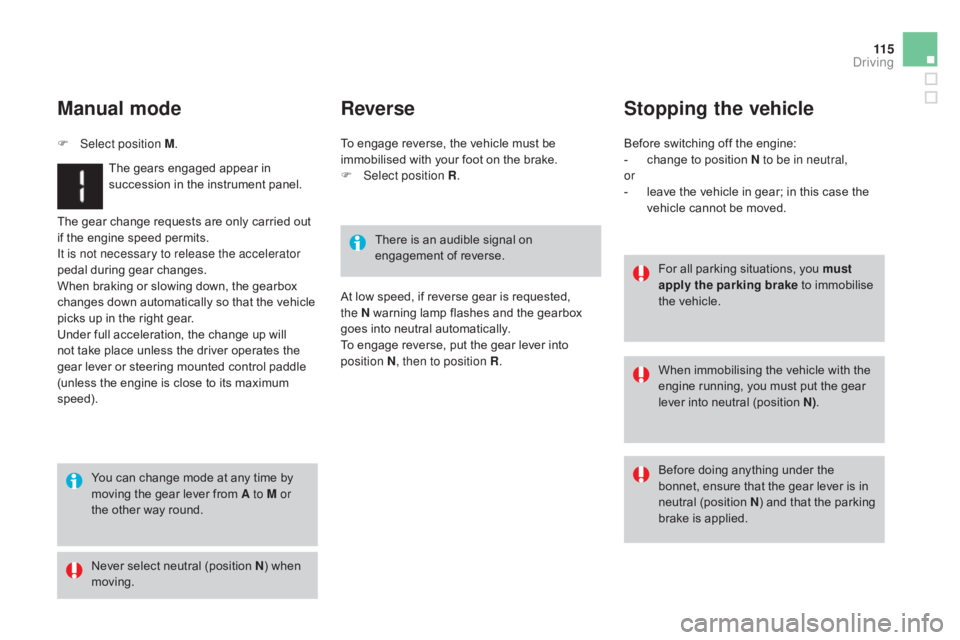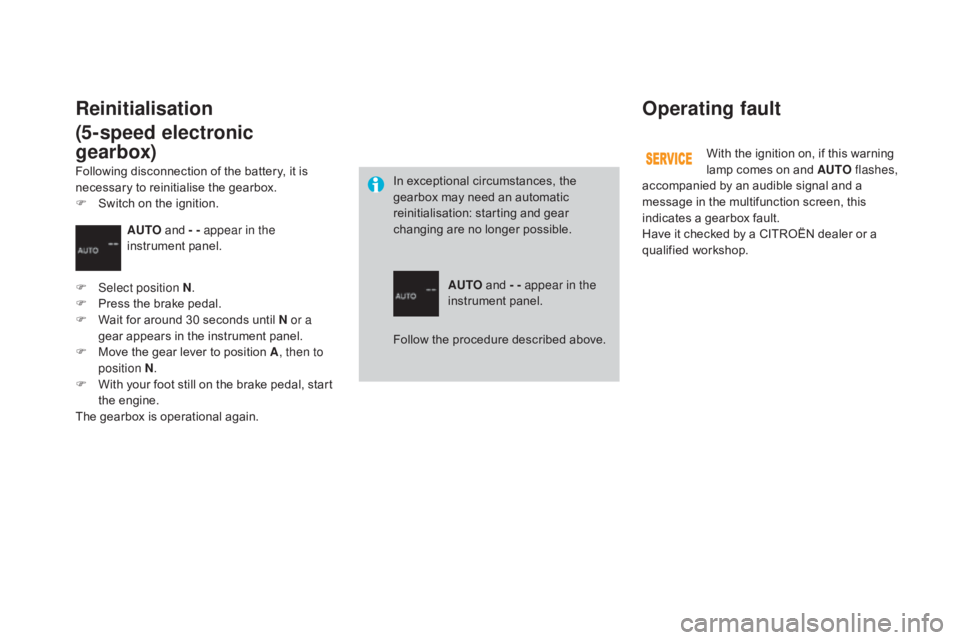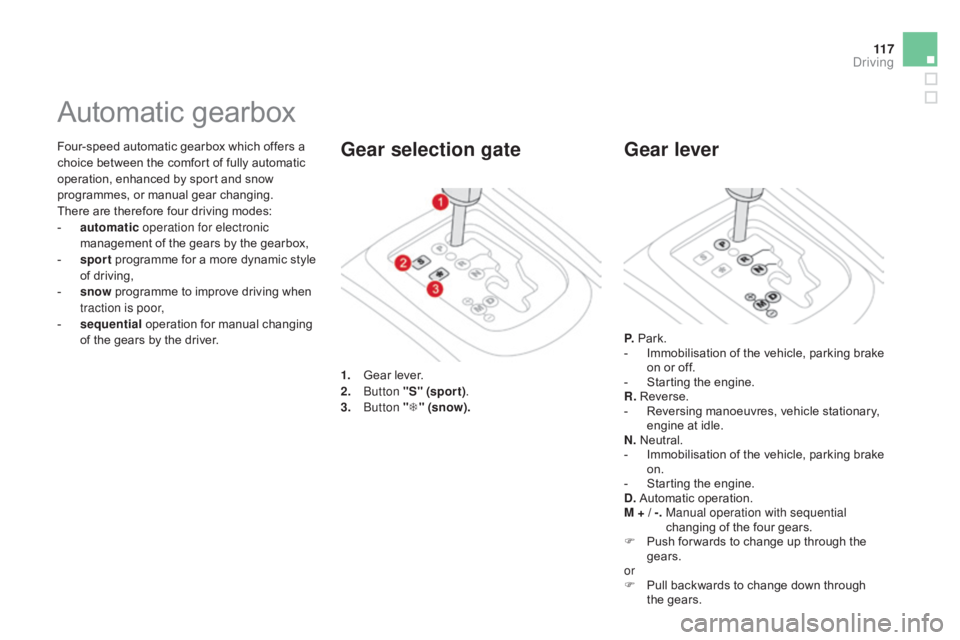gearbox CITROEN DS3 CABRIO 2015 Handbook (in English)
[x] Cancel search | Manufacturer: CITROEN, Model Year: 2015, Model line: DS3 CABRIO, Model: CITROEN DS3 CABRIO 2015Pages: 404, PDF Size: 13.2 MB
Page 117 of 404

11 5
The gear change requests are only carried out if the engine speed permits.
It is not necessary to release the accelerator
pedal
during gear changes.
When
braking or slowing down, the gearbox
c
hanges down automatically so that the vehicle
p
icks up in the right gear.
Under
full acceleration, the change up will
n
ot take place unless the driver operates the
g
ear lever or steering mounted control paddle
(
unless the engine is close to its maximum
s
peed).
Reverse
To engage reverse, the vehicle must be immobilised with your foot on the brake.
F
Sel
ect position R .
Stopping the vehicle
Before switching off the engine:
- c hange to position N to be in neutral,
or
-
l
eave the vehicle in gear; in this case the
v
ehicle cannot be moved.
Manual mode
F Select position M.
The gears engaged appear in
s
uccession in the instrument panel.
You
can change mode at any time by
m
oving the gear lever from A to M or
the
other way round.
Never
select neutral (position N)
when
m
oving. There
is an audible signal on
enga
gement
o
f
r
everse.For
all parking situations, you must
apply the parking brake
to immobilise
t
he vehicle.
When
immobilising the vehicle with the
e
ngine running, you must put the gear
l
ever into neutral (position N).
Before
doing anything under the
b
onnet, ensure that the gear lever is in
n
eutral (position N)
and that the parking
b
rake is applied.
At
low speed, if reverse gear is requested,
the N
warning lamp flashes and the gearbox
g
oes into neutral automatically.
To
engage reverse, put the gear lever into
p
osition N, then to position R .
driving
Page 118 of 404

Operating fault
With the ignition on, if this warning lamp comes on and AUTO flashes,
accompanied
by an audible signal and a
m
essage
in
the multifunction screen, this
i
ndicates
a
gearbox fault.
Have
it
checked by a CITROËN dealer or a
q
ualified
w
orkshop.
Reinitialisation
(5-speed electronic
gearbox)
In exceptional circumstances, the g earbox may need an automatic
r
einitialisation: starting and gear
c
hanging are no longer possible.
AUTO
and - - appear in the
instrument
pan
el.
AUTO
and
- - appear in the
instrument
pan
el.
F
Sel
ect position N .
F
P
ress
the
brake
pedal.
F
W
ait
for
around
30
seconds
until
N or a
gear
appears
in
the
instrument
panel.
F
M
ove
the
gear
lever
to
position
A , then to
position N .
F
W
ith
your
foot
still
on
the
brake
pedal,
start
t
he
eng
ine.
The
gearbox
is
operational
again.
Following
disconnection
of
the
battery,
it
is
n
ecessary
to
reinitialise
the
gearbox.
F
S
witch
on
the
ignition.
Follow
the procedure described above.
Page 119 of 404

11 7
Four-speed automatic gearbox which offers a choice between the comfort of fully automatic
o
peration, enhanced by sport and snow
p
rogrammes,
o
r
m
anual
g
ear
c
hanging.
There
are therefore four driving modes:
-
a
utomatic operation for electronic
management
of the gears by the gearbox,
-
sp
ort
programme for a more dynamic style
o
f driving,
-
s
now
programme to improve driving when
t
raction is poor,
-
s
equential
operation for manual changing
o
f the gears by the driver.
Automatic gearbox
1. Gear lever.
2. bu tton "S" (spor t) .
3.
bu
tton "T " (snow).
Gear selection gate
P. Park.
- I mmobilisation of the vehicle, parking brake
o
n or off.
-
S
tarting the engine.
R.
R
everse.
-
R
eversing manoeuvres, vehicle stationary,
e
ngine at idle.
N.
Neutral.
-
I
mmobilisation of the vehicle, parking brake
o
n.
-
S
tarting the engine.
d
.
A
utomatic
ope
ration.
M + / -.
M
anual operation with sequential
changing
of the four gears.
F
P
ush for wards to change up through the
g
ears.
or
F
P
ull backwards to change down through
t
he gears.
Gear lever
driving
Page 121 of 404

11 9
Automatic operation
F Select position d for automatic c hanging o
f the four gears.
The
gearbox then operates in auto-adaptive
m
ode, without any intervention on the part
o
f the driver. It continuously selects the most
s
uitable gear according to the style of driving,
t
he profile of the road and the load in the
v
ehicle.
For
maximum acceleration without touching the
g
ear lever, press the accelerator pedal down
f
ully (kick down). The gearbox changes down
a
utomatically or maintains the gear selected
u
ntil the maximum engine speed is reached.
On
braking, the gearbox changes down
a
utomatically to provide efficient engine
b
raking.
If you release the accelerator sharply, the
gearbox
will not change to a higher gear for
s
afety reasons.
ne
ver select position N while the
vehicle
is moving.
ne
ver select positions P or R unless
the
vehicle is completely stationary.
Sport and snow
programmes
These two special programmes supplement the automatic operation in very specific conditions
o
f use.
Sport programme "S"
F Press button "S" , after starting the engine.
The gearbox automatically favours a dynamic
s
tyle of driving.
S
appears in the instrument panel.
Snow programme "T"
F Press button " T", after starting the engine.
The gearbox adapts to driving on slippery
r
oads.
This
programme improves starting and drive
w
hen traction is poor.
T
appears in the instrument panel.
Return to automatic
operation
F At any time, press the button selected a
gain to quit the programme engaged and
r
eturn to auto-adaptive mode.
driving
Page 122 of 404

There is a risk of damage to the gearbox:
- i f you press the accelerator and
b
rake pedals at the same time,
-
i
f you force the movement of the
g
ear lever from the P position to
another position when the battery
is
flat.
To
reduce fuel consumption when at
a
prolonged standstill with the engine
r
unning (traffic jam...), put the gear lever in
t
he N
position and apply the parking brake.
If the lever is not in position P
,
when
the
driver's
door
is
opened
or
a
pproximately
45
seconds
after
the
i
gnition
is
switched
off,
a
warning
m
essage
appears
in
the
screen.
F
R
eturn the lever to position P ;
the
m
essage
d
isappears.
When
driving
on
flooded
roads
or
when
c
rossing
a
ford,
proceed
at
walking
p
ace.
Operating fault
Manual operation
When the ignition is on, the lighting o f this warning lamp, accompanied
b
y
an
audible signal and a message in the
m
ultifunction screen, indicates a gearbox fault.
In
this
case, the gearbox switches to back-up
m
ode
and
is locked in 3rd gear. You may feel
a
substantial knock when changing from P
to R
and
from N to R .
This will not cause any
d
amage
to
the gearbox.
Do
not
exceed 60 mph (100 km/h), local speed
r
estrictions
p
ermitting.
Contact
a
CITROËN dealer or a qualified
w
orkshop
as soon as possible.
F
Sel
ect position M for sequential
c
hanging
o
f
the
four
gears.
F
P
ush
the
lever
towards
the
+
sign
to
c
hange
up
a
gear.
F
P
ull
the
lever
towards
the
-
sign
to
change
d
own
a
gear.
It
is
only
possible
to
change
from
one
gear
to
a
nother
if
the
vehicle
speed
and
engine
speed
p
ermit;
other wise,
the
gearbox
will
operate
t
emporarily
in
automatic
mode. This
symbol
is
displayed
if
a
gear
i
s
not
engaged
correctly
(selector
b
etween
two
positions).
d
disappears
and
the
gears
e
ngaged
appear
in
succession
in
the
in
strument
pan
el.
Stopping the vehicle
Before switching off the engine, you can engage p osition P or N
to place the gearbox in neutral.
In
both cases, apply the parking brake to
i
mmobilise the vehicle.
Invalid value during manual
operation
If the engine speed is too low or too high, the gear selected flashes for a few seconds, then
t
he actual gear engaged is displayed.
It
is possible to change from position d
(automatic)
to position M (manual) at any time.
When
the vehicle is stationary or moving
v
ery slowly, the gearbox selects gear M1
automatically.
The
sport and snow programmes do not
o
perate in manual mode.
Page 124 of 404

Stop & StartThe Stop & Start system puts the engine temporarily into standby - STOP mode - during stops in the traffic (red lights, traffic jams, or other...). The engine restarts automatically - START mode - as soon as you want to move off. The restart takes place instantly, quickly and silently.
Per fect
for urban use, the Stop & Start system reduces fuel consumption and exhaust emissions as well as the noise level when stationary.
Operation
Going into engine STOP mode
For your comfort, during parking manoeuvres, STOP mode is not
a
vailable for a few seconds after
c
oming out of reverse gear.
STOP
mode does not affect the
f
unctionality of the vehicle, such as for
example,
braking, power steering...
Never
refuel with the engine in STOP
m
ode; you must switch off the ignition
w
ith the key.
The "ECO"
warning
lamp
comes
o
n
in
the
instrument
panel
and
the
e
ngine
goes
into
standby:
-
w
ith a manual gearbox ,
at
speeds
below
1
2
mph
(20
km/h),
when
you
put
the
gear
l
ever
into
neutral,
and
you
release
the
c
lutch
pedal.
-
w
ith a 5 or 6-speed electronic gearbox ,
when
stationary
or
at
speeds
below
5
mph
(
8
km/h)
(depending
on
version),
when
you
p
ress
the
brake
pedal
or
put
the
gear
lever
i
n position N .
A
time
counter
calculates
the
sum
o
f
the
periods
in
STOP
mode
d
uring
a
journey.
It
rests
itself
t
o
zero
every
time
the
ignition
is
s
witched
on
with
the
key. STOP
mode is not invoked when:
- t he driver's door is open,
-
t
he driver's seat belt is not fastened,
-
t
he vehicle has not exceeded 6 mph
(10
km/h) since the last engine start using
t
he key,
-
t
he engine is needed to maintain a
c
omfortable temperature in the passenger
c
ompartment,
-
d
emisting is active,
-
s
ome special conditions (battery charge,
e
ngine temperature, braking assistance,
a
mbient temperature...) where the engine is
n
eeded to assure control of a system.
Special cases: STOP mode not
available
The "ECO" warning lamp flashes for a
few seconds then goes off.
This operation is perfectly normal.
Page 125 of 404

123
Going into engine START mode
The "ECO" warning lamp goes off a
nd the engine starts:
-
w
ith a manual gearbox , when you
depress
the clutch pedal,
-
w
ith a 5-speed or 6-speed electronic
gearbox :
●
g
ear lever in position A or M, when you
release
the brake pedal,
●
o
r
gear lever in position N and the brake
p
edal released, when you move the gear
l
ever to position A or M ,
●
o
r
when you engage reverse gear.
Special cases: START invoked
automatically
If the system has been deactivated in STOP mode, the engine restarts
i
mmediately.
At
any time, press the "ECO OFF" switch to
deactivate the system.
This
is confirmed by the switch warning lamp
c
oming on accompanied by a message in the
sc
reen.
deactivation
For reasons of safety and for your comfort, S
TART mode is invoked automatically when:
-
y
ou open the driver's door,
-
y
ou unfasten the driver's seat belt,
-
t
he speed of the vehicle exceeds 7 mph
(11
km/h) with the electronic gearbox
s
ystem,
-
s
ome special conditions (battery charge,
e
ngine temperature, braking assistance,
a
mbient temperature...) where the engine is
n
eeded for control of a system.
The "ECO"
warning lamp flashes for
a
few seconds, then goes off.
This operation is perfectly normal.
With
a
manual
gearbox
in
STOP
m
ode,
if
you
engage
a
gear
without
f
ully
depressing
the
clutch
pedal,
a
m
essage
is
displayed
asking
you
to
f
ully
depress
the
clutch
pedal
so
that
t
he
engine
can
restart.
driving
Page 127 of 404

125
Hill start assist
System which holds your vehicle temporarily (approximately 2 seconds) when starting on a
s
lope, the time it takes to move your foot from
t
he brake pedal to the accelerator pedal.
This
function is only active when:
-
t
he vehicle is completely stationary, with
y
our foot on the brake pedal,
-
c
ertain conditions on a slope are met,
-
w
ith the driver’s door closed.
The hill start assist function cannot be
deactivated.
On an ascending slope, with the vehicle
stationary, the vehicle is held momentarily
when you release the brake pedal:
-
p
rovided you are in automated mode
(
position
A)
or in manual mode (position M)
o
n an electronic gearbox.
do n
ot leave the vehicle while it is
being
held in the hill start assist phase.
If
you need to leave the vehicle with
t
he engine running, manually apply
t
he parking brake then ensure that the
p
arking brake warning lamp is on (not
f
lashing) in the instrument panel.Operation
On a descending slope, with the vehicle
stationary and reverse gear engaged, the
vehicle is held momentarily when you
release the brake pedal.
Operating fault
If a malfunction of the system occurs, these warning lamps come on. Contact a CITROËN
d
ealer or a qualified workshop to have the
s
ystem checked.
driving
Page 130 of 404

Cruise control
System which automatically maintains the speed of the vehicle at the value programmed
b
y the driver, without any action on the
a
ccelerator
ped
al.
The cruise control is switched on
m
anually:
it r
equires a minimum vehicle speed of 25 mph
(
40 km/h), as well as the engagement of:
-
f
ourth gear on a manual gearbox,
-
s
econd gear on a or automatic or electronic
g
earbox, in sequential mode,
-
p
osition A on an electronic gearbox or
p
osition d on an automatic gearbox.
The cruise control is switched off
m
anually
o
r by pressing the brake or clutch pedal or
o
n triggering of the ESP system for safety
r
easons.
It
is possible to exceed the programmed speed
t
emporarily by pressing the accelerator pedal.
To
return to the programmed speed, simply
r
elease the accelerator pedal.
Switching
off the ignition cancels any
p
rogrammed speed value. The
controls of this system are grouped
t
ogether on stalk A.
1.
C
ruise control mode selection thumb
w
heel.
2.
V
alue decrease button.
3.
V
alue increase button.
4.
C
ruise control off/resume button.Steering mounted controls
The cruise control cannot, in any
circumstances, replace the need to r
espect speed limits, nor can it replace the
n
eed for vigilance on the part of the driver.The
programmed information is grouped
t
ogether in the instrument panel screen.
5.
C
ruise control off/resume indication.
6.
C
ruise control mode selection indication.
7.
P
rogrammed speed value.
displays in the instrument panel
Page 216 of 404

Removing a wheel
Parking the vehicle
Immobilise the vehicle where it does not block traffic: the ground must be
l
evel, stable and not slippery.
Apply
the parking brake, switch off the
i
gnition and engage first gear* to lock
t
he wheels.
If
necessary, place a chock under the
w
heel diagonally opposite the wheel to
be c
hanged.
It
is imperative that you ensure that the
o
ccupants get out of the vehicle and
w
ait where they are safe.
Never
go underneath a vehicle raised
u
sing a jack; use an axle stand.
List of operations
F Remove the chromed bolt cover from each o
f the bolts using the tool 3 (alloy wheels
o
nly).
F
F
it the socket 4 on the wheelbrace 1 to
slacken
the security bolt (if your vehicle is
f
itted with them).
F
S
lacken the other bolts using the
w
heelbrace 1
o
n l y.
* position P
for
an
automatic
gearbox. Ensure
that the jack is stable. If the g
round is slippery or loose, the jack
c
ould slip or drop - Risk of injury!
Take
care to position the jack only at
o
ne of the jacking points A or B under
t
he vehicle, ensuring that the vehicle's
c
ontact sur face is well centred on the
h
ead of the jack. Other wise, there is a
r
isk of damage to the vehicle and/or the
j
ack might drop - Risk of injury!